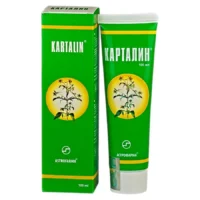Description
AlergoDerm (fluocinolon) Ointment 0.25 mg/g. 15 g Tube
Ingredients
Active ingredient: Fluocinolone acetonide 0.25 mg/g. Other ingredients: [list other ingredients]
Mechanism of Action
Fluocinolone acetonide, the active ingredient in AlergoDerm ointment, is a potent corticosteroid that exerts its anti-inflammatory and anti-pruritic effects by inhibiting the production of inflammatory mediators and suppressing the immune response in the skin.
Pharmacological Properties
AlergoDerm ointment possesses potent anti-inflammatory, anti-pruritic, and vasoconstrictive properties, making it effective in alleviating the symptoms of various corticosteroid-responsive dermatoses.
Indications for Use
Indicated for: Relief of inflammatory and pruritic manifestations of corticosteroid-responsive dermatoses such as eczema, psoriasis, and allergic reactions.
Contraindications
Contraindications: AlergoDerm ointment is contraindicated in individuals with a known hypersensitivity to any component of the product. It should not be used on infected or open wounds.
Side Effects
Common side effects of AlergoDerm ointment may include skin irritation, burning, itching, dryness, or redness at the application site. Prolonged use or excessive application may lead to skin thinning or discoloration.
Usage Instructions
Dosage: Apply a thin layer of AlergoDerm ointment to the affected area 2-4 times daily. It is important to follow the prescribed dosage and duration of treatment as directed by your healthcare provider.
Benefits Compared to Analogues
AlergoDerm ointment offers superior efficacy in managing inflammatory and pruritic dermatoses compared to traditional emollients or less potent corticosteroids. Its targeted action and lower risk of systemic side effects make it a preferred choice for many patients.
Suitable Patient Groups
AlergoDerm ointment is suitable for use in adults, children, and the elderly under appropriate medical supervision. Dosage adjustments may be necessary in certain populations, such as pediatric patients or individuals with compromised liver function.
Storage and Shelf Life
Store AlergoDerm ointment at room temperature away from moisture and heat. Check the product packaging for the specific storage conditions. The shelf life of the ointment is typically indicated on the tube or outer packaging.
Packaging Description
AlergoDerm ointment is available in a 15 g tube for topical application. The packaging should include detailed instructions for use, dosage information, and a list of ingredients for reference.





